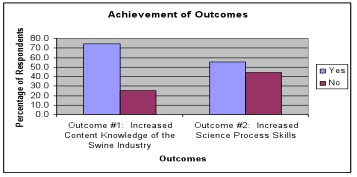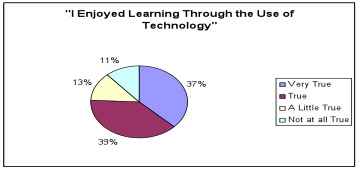 |
February 2010
|
February 2010 // Volume 48 // Number 1 // Ideas at Work // v48-1iw3
A Science, Engineering and Technology (SET) Approach Improves Science Process Skills in 4-H Animal Science Participants
Abstract
A new Science, Engineering and Technology (SET) approach was designed for youth who participated in the Minnesota State Fair Livestock interview process. The project and evaluation were designed to determine if the new SET approach increased content knowledge and science process skills in participants. Results revealed that youth participants not only increased both knowledge and skills, but specifically enjoyed learning through technology. Results of this pilot project suggest that using a SET approach for animal science programs, specifically utilizing technology as a learning tool has considerable merit.
Introduction
4-H animal science projects have been the cornerstone of many 4-H programs that teach life skills (Knowlton-Ward, 1996). In addition to life skills, science process skills help young people learn to think like scientists. Process skills are the focal point for the 4-H Science, Engineering and Technology (SET) program. Young people gain process skills through Inquiry-Based Learning, a 4-H SET approach. In Minnesota, a new SET approach to the livestock interview experience has led to increased livestock content knowledge and process skill development.
In 2005, National 4-H identified the Science, Engineering and Technology (SET) program area as one of three National Mission Mandates. Of the National SET outcomes identified, this project focused on increasing content knowledge and developing science process skills (Silliman, 2007). Criteria for delivering SET programs include the following.
- Programs are based on the National Science Education Standards.
- Youth have opportunities to improve their SET abilities.
- Youth experience and improve in the essential elements of Positive Youth Development.
- Learning experiences are led by trained, caring adult staff and volunteers who operate from a perspective that youth are partners and resources in their own development.
- Activities are led with a hands-on, experiential approach to learning using inquiry to foster the natural creativity and curiosity of youth (National 4-H Council, 2008).
Of the 9,949 youth currently enrolled in animal science projects in Minnesota 4-H, 2,687 exhibited a livestock project at the 2008 Minnesota State Fair. In 2008, the livestock interview experience was piloted with 434 youth exhibiting swine and was re-designed to align with identified SET criteria. The experience included an educational learning workshop, an on-line test, and a one-on-one interview.
Program Design
All 4-H swine exhibitors participated in one of two educational workshops that were 20 minutes long and led by scientists and swine industry professionals. Following the educational workshop, all exhibitors participated in an on-line assessment that tested swine project area knowledge. The on-line assessment included 15 and 18 questions for grades 6-8 and 9-13, respectively. Participants who scored in the top 20% were called back for a one-on-one interview with a swine industry expert. The one-on-one interviews allowed youth to analyze and reason through hypothetical situations faced by producers and members of the swine industry. Merit was assigned to those able to demonstrate effective communication and professional skills. The one-on-one interview process used a standard rubric to increase objectivity.
A Survey Monkey evaluation, developed for participants, focused on several areas. Sample questions included the following.
- Did participants increase science process and content skills?
- How did participants enjoy learning through the use of technology?
- How did this interview experience compare with past Minnesota State Fair interview experience(s)?
Sixty-seven swine participants responded to the survey. Participants were asked two questions about the attainment of both content knowledge and science process skill outcomes. Participants responded yes or no based on their experience related to the achievement of outcomes.
Results
The program evaluation was designed to determine if the new SET approach to the interview process was effective in achieving increased content knowledge and science process skills in participants. Participants self-reported an increase in both content knowledge and science process skills. Quantitative and qualitative results are shown below.
Figure 1.
Achievement of Outcomes

Results showed 75% of respondents increased their content knowledge and 55% reported their science process skills increased.
Participants were asked if they enjoyed learning through the use of technology. Respondents rated their enjoyment of using technology based on a four-point scale from very true to not at all true. Figure 2 depicts responses.
Figure 2.
Use of Technology

The results showed 76% of respondents reported they enjoyed learning through technology as "true" or "very true."
When asked for comments on what participants enjoyed most about the interview process (without any prompted responses), 40% qualitatively reported the technology portion was most engaging, enjoyable, and meaningful. Specific comments to this question included the following.
"I liked the technology portion best because previously when we were in a group I felt I didn't want to express my knowledge because they would think it was dumb if I was wrong and the computer kept it confidential."
"I like the technology piece best because I could go at my own pace."
Of the 67 respondents, 51 participants had experienced the livestock interview process prior to 2008, and 84.3% of them reported that the process was more engaging than in the past.
Implications and Recommendations
One question in the survey specifically asked participants what they enjoyed most about the experience. A majority of qualitative survey responses credited the use of technology as the aspect that made the process most enjoyable. Based on the evaluation data, various technology tools should be used more frequently in additional aspects of youth programming, such as social networking, communicating, and blogging.
According to the results, the SET approach to an animal science project experience proved to increase content knowledge and process skills. The success of the State Fair livestock interview process provides a basis for embedding SET in the larger Animal Science program. Recommendations for future applicability of SET in the animal science program include the following.
- Expand pilot experience to all livestock species at the 2009 Minnesota State Fair.
- Create a technology venue for youth to learn about their animal science projects. Examples may include technology-based assessments, social networking platforms, connecting via the Web to animal science, and/or blogging about animal science projects with youth and/or caring adults.
References
Knowlton-Ward, C. (1996). Life skill development related to participation in 4-H animal science projects. Journal of Extension [On-line], 34(2) Article 2RIB2. Available at: http://www.joe.org/joe/1996april/rb2.php
National 4-H Headquarters. (2007). Critical indicators of youth development outcomes for 4-H national mission mandates. USDA. Retrieved January 9, 2009 from: http://www.national4-hheadquarters.gov/
National 4-H Council. (2008). Science, engineering and technology criteria checklist. Retrieved January 2, 2009 from: http://www.fourhcouncil.edu/




